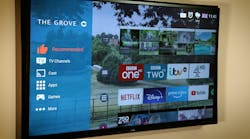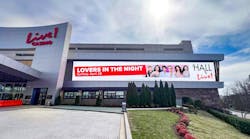Februray 21, 2019
What an inspiring conference Arc Advisory hosted in Orlando, FL, February 4-6! More than 1,000 participants from industry and the public sector attended the meeting. Thanks to Jim Frazer and Rob D’Angelo for hosting the smart cities track for the first time. Jim invited Charles Ramdatt, Chris Davis, Greg Carter, Larry Ceppos, and myself to participate in a spirited discussion on how LED lighting can catalyze smart cities. I heard some great ideas and tips for civic leaders who want to kickstart their smart city agenda by delving into lighting.
Pedestrian Bridge at Mercer University, Macon, GA
Photo © Christopher Smith
The panel speculated on what it takes to start and complete a successful smart city project. Everyone agreed on the following four foundational steps (not too different from some of the US DoT’s best practices recommendations for good project execution as Jim pointed out!):
(1) Define your priorities as a community,
(2) Determine your ALL funding sources from financing, grants, CAPEX budget, and more
(3) Engage your stakeholders early and often, including community members, private sector, startups, education, state and federal partners who can help fund projects,
(4) Build a foundational technology platform, by selecting robust, proven and future-proof technology.
Capacity building grants from the Smart Cities Council or best practices sharing from organizations like the United States Conference of Mayors provide templates and technical assistance to public entities during the priority-setting stage. Leverage other state-wide or federal monies as much as possible. Smaller communities can team up to access some of these supports. We recently compiled a how-to guide for architectural lighting projects that walks through similar steps.
Once you’ve defined your stakeholders, the next step is to select use cases and success criteria that will drive your selection of the right partners and technologies. Start with your mission and then extract requirements that will support it rather than focusing only technical features. Think of technology as an enabler rather than the outcome. Tools need to support your workforce and build 21st century competencies.
As you vet different solutions, you need to have flexibility and scalability. Charles Ramdatt gave a great example from Orlando – a city with a population of 3 million that welcomes 72 million visitors reach year. He described how the public works department is able to move critical communications infrastructure on mobile units to accommodate large events. Lighting is another one of those versatile urban infrastructures that can transform shared spaces from an everyday plaza to a festival space, signify a bike lane or a pedestrian zone or support the quick throughput of vehicular traffic during rush hour.
After sharing some thoughts on scalability, Jim grounded us in the need to implement sustainable technologies in an economically viable way. He talked about the three-layer model of sustainability starting with the (1) preservation of the environment, (2) the support of human wellbeing, and finally (3) the ability to do these things economically. Audience members pointed out how city services are changing and how vendors are providing more and more sophisticated offerings of hardware, software and services. Some of these offerings are difficult to compare but if the mission and outcome are clear cities can deliver. Charles Ramdatt described how Orlando is collaboration with Florida State University for job training. Larry Ceppos described innovative parking solutions in Winter Park, FL.
All in all, this discussion was one of the best I’ve had in a long time on smart cities. It was grounded and thoughtful – we focused on the needs of citizens and hopefully gave audience members some concrete ways technology can help them achieve higher service levels for them.






